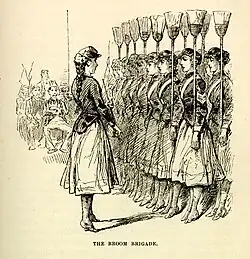Broom brigade

Broom brigades were organized women's groups that performed military-style drills using brooms instead of rifles during the late 19th century. These brigades became particularly popular in the 1880s across the United States, especially during patriotic events such as the Fourth of July. The term broom brigade was famously referenced by Mark Twain in his book Life on the Mississippi (1883), where he described watching a group of women in New Orleans perform their drills with "grace, spirit, and admirable precision," humorously noting that they did everything with a broom except sweep. Broom brigades reflected a blend of cultural ideas. On one hand, they aligned with the "cult of domesticity" prevalent at the time, which emphasized women's roles as caretakers and homemakers. On the other hand, their participation in public demonstrations of martial skill—such as military drills and marches—signaled shifting gender norms and the expanding roles of women in public life, including activities traditionally associated with men..[1][2][3]
Brigades
- St. Louis Ladies Broom Brigade Michigan (1870s)[4]
- Ladies of the Russian Broom Brigade of St. Louis, MO (1882)[5]
- The Woman's Relief Corps (1883) women's auxiliary to the Grand Army of the Republic.
- Hamilton Broom Brigade (1884)[6]
- Company Q, (1888) University of Minnesota.[7]
- Broom Brigade, Union (1889)[8]
- Kilbourn Broom Brigade, Wisconsin Dells, Wisconsin (1888)[9]
- Breckenridge Broom Brigade, Caldwell Co., Missouri, (c. 1890)[10]
Current usage
Currently the term refers to citizens who volunteer to clean up their neighborhoods.[11]
See also
References
- ^ Hale, Whitney (August 31, 2012). "Sesquicentennial Series: The Charge of the Broom Brigade". UKNOW. LEXINGTON, Ky. Retrieved February 5, 2013.
- ^ https://blogs.loc.gov/inside_adams/2016/11/the-rise-of-the-broom-brigade/
- ^ https://www.vintag.es/2016/07/broom-brigade-c1880s.html
- ^ "Mid-Michigan History: St. Louis Ladies Broom Brigade". Morning Sun. October 8, 2012. Retrieved February 5, 2013.
- ^ A. M. Shuey (composer); Minn (composer) (1882). "Russian Broom Brigade Triumphal March. In the Palace Ballroom Car Over the River Bank Route of the Chicago Milwaukee & St. Paul Railway". JScholarship. Archived from the original on February 7, 2014. Retrieved February 5, 2013.
- ^ "Hamilton Broom Brigade". Butler County Historical Society. Rootsweb. 2000. Retrieved February 5, 2013.
- ^ Brady, Tim (September–October 2004). "The Broom Brigade". University of Minnesota Alumni Association. Archived from the original on March 5, 2016. Retrieved February 5, 2013.
{{cite journal}}: Cite journal requires|journal=(help) - ^ Allen, Craig (2005). "Broom Brigade of Union, 1889". Oregon Historical Society. Retrieved February 5, 2013.
- ^ Bennett, H. H. (December 2003). "Kilbourn Broom Brigade on the Alexander Mitchell". Wisconsin Historical Society.
- ^ Breckenridge Broom Brigade
- ^ "Britain vows to restore order to quell riots". CBC. August 9, 2011. Retrieved February 5, 2013.
A 'broom brigade' gathers Tuesday at the site of rioting in Clapham to volunteer in cleanup efforts. (photo caption)
External links
- Gary A. Mitchell, "Why Can't A Girl Be a Soldier? The Importance of Female Military Organizations, 1875–1900, Army History (Winter 2022): 30–39.
- Broom Brigade March. The Lester S. Levy Collection of Sheet Music, Edward Wittich (composer) 1883
- Barnett, Joseph H. (1978) [1890]. Barnett's broom brigade tactics and fan drill: suitable for school, church, social, or military entertainment for boys and girls (5th reprint ed.). M & M. 69 pp.
- Illustration from "Life on the Mississippi". (Ch 44)